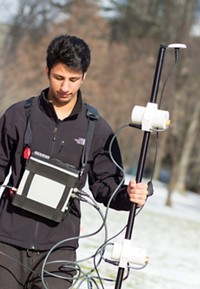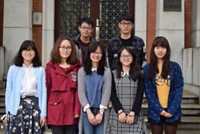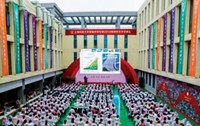Advertisement
Grab your lab coat. Let's get started
Welcome!
Welcome!
Create an account below to get 6 C&EN articles per month, receive newsletters and more - all free.
It seems this is your first time logging in online. Please enter the following information to continue.
As an ACS member you automatically get access to this site. All we need is few more details to create your reading experience.
Not you? Sign in with a different account.
Not you? Sign in with a different account.
ERROR 1
ERROR 1
ERROR 2
ERROR 2
ERROR 2
ERROR 2
ERROR 2
Password and Confirm password must match.
If you have an ACS member number, please enter it here so we can link this account to your membership. (optional)
ERROR 2
ACS values your privacy. By submitting your information, you are gaining access to C&EN and subscribing to our weekly newsletter. We use the information you provide to make your reading experience better, and we will never sell your data to third party members.
Careers
Educational Alliance Takes Next Step
Singaporean universities and MIT launch second phase of their education and research partnership
by Celia Henry Arnaud
February 27, 2006
| A version of this story appeared in
Volume 84, Issue 9

COVER STORY
Educational Alliance Takes Next Step
A distance-learning partnership between Singapore- and U.S.-based universities is set to soar. The Singapore-MIT Alliance (SMA) is an education and research program initially launched in 1998 as a partnership between the National University of Singapore (NUS), Nanyang Technological University, and Massachusetts Institute of Technology. In the program, participating professors and students from MIT and Singapore learn and collaborate with each other from halfway around the world. SMA launched its second phase last summer with four programs; the fifth program will start this summer.
The second phase of the program will differ significantly from the first. In SMA-1, students took classes with MIT and Singapore professors while earning a master's or Ph.D. from one of the Singaporean universities and an SMA certificate. A number of courses were taught by MIT professors and beamed around the globe to students in Singapore via the Internet. The students spent most of their time in Singapore, traveling to MIT only for a two- to three-week summer program.
In SMA-2, the students will be full-fledged students at both MIT and one of the Singaporean universities, earning separate degrees and spending a significant chunk of time in both places. The distance-learning component, nonetheless, will continue to be a hallmark of SMA-2.
Although MIT professors were deeply involved in SMA-1, the institute refrained from granting its own degree as part of the program, partially because of concerns about the effectiveness of distance learning. "SMA-1 was really an experiment to see whether you could provide what we consider to be an MIT-quality education with a significant distance component," says Anthony T. Patera, a professor of mechanical engineering at MIT and SMA codirector.
Gregory N. Stephanopoulos, a professor of chemical engineering at MIT and cochair of the SMA program in chemical and pharmaceutical engineering (CPE), was initially uncertain how it would feel to lecture to students 6,000 miles away. "It reached a point that distance was no factor," he says. "The only things that reminded me were the late hour and the fact that I had things strapped on me to connect me to the microphone. It was almost like having students in the classroom." (Classes must be taught early in the morning or late at night to accommodate the 13-hour time difference.) Because the course was cross-listed in MIT's catalog, Stephanopoulos did have anywhere from 15 to 35 students in the room with him.
The experiment apparently was a success, because SMA-2 has been launched and the CPE program is now evaluating applications from students who will start in July 2006. "People felt comfortable with the fact that it was a true MIT experience," Patera says.
Students now must apply directly and independently to both MIT and the Singaporean universities. Applicants will be screened and admitted according to normal admissions procedures at the respective institutions. Only those admitted by both universities will be eligible for an SMA graduate fellowship. "We want to make sure this is not a back-door entrance to any of the participating universities," says Ng Wun Jern, professor of environmental science and engineering at NUS and SMA codirector.
Some of the requirements for the students are changing with the change in their status at MIT. "Because they are now MIT students, they must honor all the standard requirements that MIT imposes," Patera says. "For example, for an MIT master's, the minimum residency in Cambridge is one semester."
SMA-2 will offer degrees in five areas: advanced materials for micro- and nanosystems, chemical and pharmaceutical engineering, computation and systems biology, computational engineering, and manufacturing systems and technology. Each of these programs, with the exception of systems biology, offers students the option of earning an MIT master's with either a Singaporean master's or a Singaporean Ph.D. Ph.D. candidates will be jointly supervised by MIT and Singaporean faculty members. The systems biology program will award a Ph.D. with an SMA certificate.
The CPE program will admit 20 students, 16 for master's degrees and four for Ph.D.s. Of the 16 master's students, three will be allowed to continue for a Ph.D. Each student receives a fellowship that pays for tuition at both schools, as well as a stipend.
The MIT master's degree in the CPE program is awarded by MIT's David H. Koch School of Chemical Engineering Practice, known as the Practice School. Instead of writing a thesis, the students participate in industrial internships, chosen from Practice School stations located around the world.
"It is industrial leadership training," says Raj Rajagopalan, head of the department of chemical and biomolecular engineering at NUS and cochair of SMA's CPE program. "In many cases in the pharmaceutical industry, you don't need a Ph.D. What the students need to know is what the real-life problems are and how to solve them."
In SMA-1, the students remained in Singapore for their Practice School assignment, called industrial immersion, but that is certain to change in SMA-2, Stephanopoulos says. "SMA students are going to be blended with MIT students, and they're going to be sent to different Practice School stations around the world," he says.
SMA-2 will have a fairly large research component, which can be divided into two categories: flagship projects and interuniversity projects. The flagship projects address challenging problems at the forefront of science and engineering and involve large groups of faculty from all the universities, as well as researchers from industrial and government research institutes in Singapore. The interuniversity projects involve more focused research problems designed to foster more intimate collaboration among faculty members.
In the CPE program, the flagship project focuses on molecular engineering of biological and chemical pathways and process science for the pharmaceutical industry. Within that overarching theme, there are three thrusts-metabolic engineering, chemical catalysis, and novel separation and purification concepts. The choice of the flagship projects was the result of nearly a year's deliberation, says Lee Jim Yang, a participating professor of chemical and biomolecular engineering at NUS.
In addition to students from Singapore, the program draws students from other Asian countries. For the CPE program, representatives visited universities in India and China to recruit students. Final funding approval for SMA-2's CPE program was received only in October, with an application deadline of Jan. 2. But word got out early enough that the CPE program attracted about 50 applicants, Rajagopalan says.
Both sides benefit from the program. MIT views the alliance as a portal into Asia, according to Patera. "Singapore is a hub for multinationals and increasingly also a real center for technology in Asia."
The Singaporean universities have learned from their experiences with MIT, Ng says. "I was the dean when the SMA-1 program was kicking in. At that point, I spent a fair bit of time observing how things were done at SMA and by extension how things were done at MIT," he says. He believes that the universities have learned lessons in how MIT organizes research programs, selects and rewards its faculty, and reaches out to industry.
"Many of these lessons were transferred into the faculty of engineering," Ng says. "I think the school as a whole has improved because of this learning experience."
SMA is primarily funded by interested parties in Singapore, including government agencies and the universities. "Each one has its own expectations," Ng says, such as improving the international rankings of the Singaporean universities and developing research manpower. "It takes some skill to balance things," Ng says. "Everybody seems to be reasonably satisfied to the extent that they continue to give us money."





Join the conversation
Contact the reporter
Submit a Letter to the Editor for publication
Engage with us on Twitter